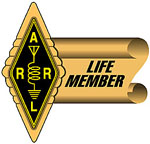for more of them.
HAM meant Poor Operator
One common story says that initially amateurs were not welcomed by
the military and commercial stations who they shared the airwaves with, and
were refered to by the derogatory term "ham", which meant someone who was
a poor quality operator. This would be similar to saying that someone was "ham
fisted" which meant that they could not send CW very well.
Railroad telegraphers used it as a serious insulting term for a poor operator.
The term "lid" was also used.
This theory is well substantiated. A search in old articles in QST
found the following in the July 1945 issue, page 78, a letter from
Roy Wheadon, W6KTY. He was the son of a railroad telegraph operator
and said he knew this from personal experience.
Most of the students
were young farm boys, who served their apprenticeship as
unpaid helpers for the overworked station agents, who in return
taught them telegraphy.
As I understood it in my younger days,
the word ham had a bucolic reference to the farm origin
of most of the student railroad telegraphers.
I know it was a disgrace to be called a ham.
The letter was in response to the editorial in the May 1945 QST
(pp 9-10) by Kenneth B. Warner, W1EH.
He alludes to the term ham as defined in a book called
Dictionary of American Tramp and Underworld Slang.
According to that, it says ham meant:
A telegraph operator or radio amateur. Abbreviation for hammer
because the key operates with an up and down motion
similar to a hammer.
Applied in a derogatory sense as an amateur does not
have a light and gentle touch, but hammers the key.
The same editorial also related the story of how the word ham
came from the Cockney English pronunciation of the word
amateur, h'amateur. More on that elsewhere here.
Poor Little Station HAM
I have also heard the story that three guys used the initials of their names for their
station callsign "HAM" and how their plight was brought to the attention of Congress
when the big stations were trampling all over "poor station HAM." As a result,
frequency allocations were first established and amateur stations officially
recognized and licensed by the government.
This one is supposedly substantiated by the Congressional Record
but for some strange reason no one can name the exact volume. Hmmm.
I have now found yet another explanation. It comes from a newspaper article
first published in 1948. The text of that article follows.
(Emphasis is mine.)
THE DAILY JOURNAL
Wheaton, Illinois DuPage County
February 18,1948.
Sixteen radio amateurs, all holding government licenses to transmit on the
amateur bands, met recently to discuss the possibilities of an organization for
Wheaton. The meeting was held at the DuPage county courthouse and the
evening was spent in getting acquainted and in talking of plans for a future
amateur radio club.
Known as hams, not from the connotation as used on the stage to denote
strictly underate performances, but from the English attempt to pronounce
the word amateur, these sixteen represented a range from freshmen in high
school to old-timers whose early days included spark transmissions. Most of the
group have known each other over the air for some time, but the meeting offered
the first chance for them all to become personally acquainted.
Many Notable Amateurs
When the club perfects its organization, it will include some notable amateurs
who are well known around the world. Frank Golder, K9AAM of Warrenville, has
been in radio for many years, but only recently joined the amateur ranks. He has
run up a total of 74 countries, contacted through his work on 20 meters, one of
the allotted amateur frequencies.
Bill Newcomb, W9QES and his wife Alice, W9QMS, have friends all over the
world through their work on 20 meter phone. Emerson Squires, W9BRX, has a
call which dates back to his high school days at Wheaton Community High
School. Emerson is presently most active on the amateur radio 20 meter phone
band.
From QST, January 1999, Page 75
Hamletter - Wheaton Community Radio Amateurs, April/May 1998
 Disclaimer:
Disclaimer: Copyright © 1998 N7JY.
Copyright © 1998 N7JY. You're looking at the web page for John Bartholomew, N7JY
([email protected])
which was started on August 28, 1997.
You're looking at the web page for John Bartholomew, N7JY
([email protected])
which was started on August 28, 1997.